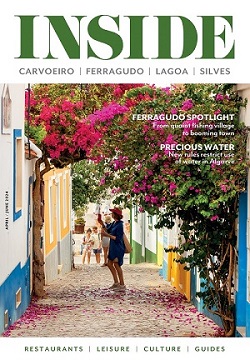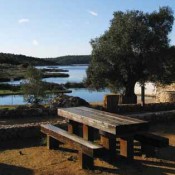
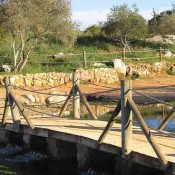
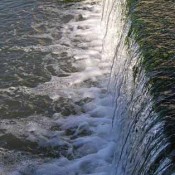
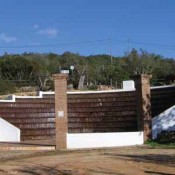
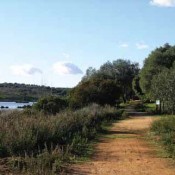
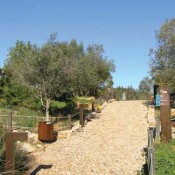
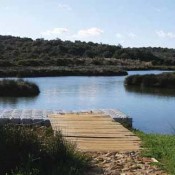
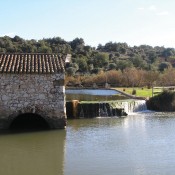
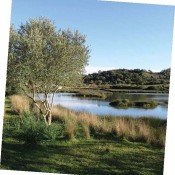
The Sítio das Fontes is the perfect setting for some fine-weather exercise, to lose unwanted pounds, or simply for a relaxing walk.
The Sítio das Fontes Muncipal Park, 1.5 km outside Estômbar, in the municipality of Lagoa, covers an area of 18 hectares, at the start and along the banks of a creek on the left bank of the River Arade. It owes its name, translating to “Place of the Springs”, to the presence of many springs that bubble up here and which boast the heaviest flow of the Algarve’s largest aquifer, known as Lias-Dodger or Querença-Silves.
Since the land in which the park is located was acquired, in 1989, Lagoa Municipal Council has restored some of the existing buildings, such as the tide mill, the miller’s house and old irrigation system, while others, such as the reception building, the warden’s house, the toilets, the amphitheatre, the picnic area, the fitness circuit, the Nature Interpretation Centre and a small wharf were built from scratch. As a whole, the park offers visitors a choice of activities to spend the day surrounded by nature, soaking up stunning views over the River Arade.
The sign-posted walking trail inside the park is only 1.7 km long, but it takes you through a range of landscapes, including salt marsh, Mediterranean scrubland, a temporary pond, pools and waterways and abandoned farmland. For the more active, there is an extensive fitness circuit, while following the trail’s yellow signs affords you a pleasant stroll. The trail starts at the park entrance, on the right side of which stands a wheel-operated well, which was used to irrigate the farmland once here. The Nature Interpretation Centre stands behind this, in a fully renovated traditional Algarve house. The centre organises workshops and walks throughout the year, including dragonfly watching, and can be visited by appointment (Tel 282 432 784/282 380 400, [email protected]). Passing through the picnic area, furnished with wooden benches and tables, and barbecues, and behind the park’s reception building, you are treated to a first impressive view over the park and over the creek, in which, depending on the time of year, you can see hundreds of water bird species.
The biodiversity of the habitats found here and the seasonality of plant and animal species, reflect the typically Mediterranean climate, with scarce and irregular rainfall in winter months and summers mellowed by offshore winds from the Atlantic. Formerly, the areas surrounding the park were thick with carob, almond and fig trees, as well as olive groves. But farming has long been forgotten in these parts and nature has taken over. Nature’s revival has led to the arrival of other species, including the pepper tree, the dwarf palm, the kermes oak, cistus gums and, depending on the time of year, you can also see wild orchids and squills.
The trail then leads to the bank of the creek and a few metres later you reach, on the left side of the path, a white column, with a sign revealing the end of the park and of the trail. Nevertheless, anyone choosing to continue along the trail beside the water won’t regret it. The scenery is of breathtaking beauty. Surrounded by nature at its purest, only birdsong interrupts the silence. After about 700 metres, you come to the River Arade. It’s almost impossible to imagine just how important this river, the source of which lies in the hills of the Serra do Caldeirão and which reaches the Atlantic between Ferragudo and Praia da Rocha, once was. For hundreds of years it was the communications route that enabled Silves to become the capital of the Al-Gharb kingdom under Moorish rule. Products from the Silves region were exported to the world via the river and Phoenicians, Carthaginians, Greeks and Romans reached the city along it. The subsequent silting of the river means that only small leisure craft are able to navigate upstream now. A river trip, which locals and visitors to the region should make at least once in their life.
Returning on the same path to the park, the trail now takes you to the old tide mill. There are about 20 mills of this kind between Portimão and Silves. Unfortunately most of them have been abandoned and are now nothing more than ruins. Records of this mill date back to the 15th century, when it is mentioned in the “Book of Silves Warehouse”, as a “(…) place of springs in which Vicente Pirez has a mill (…)”. The miller’s house, which has also been renovated, stands next to the mill. The municipal council has also built an open-air amphitheatre nearby, which in the summer stages concerts and other events, such as the international Didgeridoo festival, or the “Obrigado Portugal” festival, organised by the resident foreign community. The final section of the trail takes you over the wooden bridge, across the mill’s tanks and next to a small pond at the end of one of the tanks, back to the start of the trail. Prior to the summer bathing season the two tanks, of varying depths, are cleaned so as to remove any algae and provide refreshing pools for visitors.
The fact that the trail has come to an end doesn’t mean that you need leave the park. You can take a break in the picnic area, while your children enjoy the playground, or take a refreshing dip.
Insider’s tip: the park is very busy at the weekend. If it’s peace you’re looking for, visit the park during the week.
How to get there:
In Estômbar, take the road towards Silves, passing the school and football pitch. After 800 metres you pass under the A22 motorway and then 200 metres later the Sítio das Fontes is signposted. Following the sign, to the left, a few metres later you reach the car park.
Text & photos Anabela Gaspar













